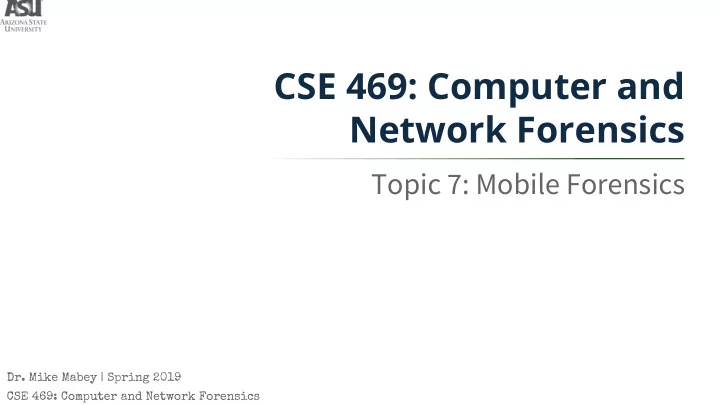

CSE 469: Computer and Network Forensics Topic 7: Mobile Forensics Dr. Mike Mabey | Spring 2019 CSE 469: Computer and Network Forensics
Overview of Mobile Forensics ● Originated in Europe and focused on the GSM SIM card. Roaming of Devices from Network and Spectrum Required - I.D. Info on SIM – Also SMS, Phonebooks, and Last Numbers Dialled on SIM ● Terrorist use of phones as IED detonators Increased the demand for mobile forensics. Mobile device forensics is making a real impact in the war on terror. ● Adoption Has Moved Quickly From Federal to Local Level and Now Enterprise, Prisons, Schools, etc. 2 CSE 469: Computer and Network Forensics
What is Mobile Forensics? ● A branch of digital forensics relating to recovery of digital evidence or data from a mobile device under forensically sound conditions. ● Involves recovering data specific to mobile platforms. ● Can refer to any device with internal memory and communication ability, like PDA or GPS devices. ● There are multiple methods / tools for data extraction, and no single method is best. 3 CSE 469: Computer and Network Forensics
Brief History (1) ● Mobile Forensics recognized as a branch of Computer Forensics in late 90’s / early 2000’s. ● Early Examination Methods: ● Manually operating through the devices – Became more challenging with complex devices. ● Using synchronization software – Unable to recover deleted data. 4 CSE 469: Computer and Network Forensics
Brief History (2) ● More Modern Examination Methods: ● Use of OEM flasher tools – Used by OEMs to program the device memory ● Debugging, Overwriting non-volatile memory, copying the memory. ● Potentially compromise data integrity. ● Use of Automated Commercial / Specialized tools ● Little risk of losing data integrity ● Can recover deleted data ● Eg. Lantern (Katana Forensics), MPE+ (Access Data) 5 CSE 469: Computer and Network Forensics
Mobile Forensics Stats ● 80% of All Criminal Investigations in Europe Involve Mobile Device Forensics ● 90% of All Criminal Investigations in UK ● 70% in US (estimate and growing) ● Quickly Becoming The Necessary Part of Every Investigation! 6 CSE 469: Computer and Network Forensics
Mobile Forensics vs Computer Forensics ● Computer Forensics: Major Operating System Standards: Windows, Mac, Linux. ● Standard practice is to image the Hard drive and Examine Data. ● ● Mobile Forensics: Multiple Operating Systems. ● Various Communication Standards. ● Mobile Forensics is becoming more like computer forensics in some ways. ● ● Mobility Aspect: Phones are Live Things Roaming Around. ● It’s not only just about what’s on the device, but where has it been and ● what connections have been made? 7 CSE 469: Computer and Network Forensics
What data is obtainable? ● FROM SIM Cards: ● IMSI: International Mobile Subscriber Identity ● ICCID: Integrated Circuit Card Identification (SIM Serial No.) ● MSISDN: Mobile Station Integrated Services Digital Network (phone number) ● LND: Last Number Dialled (sometimes, not always, depends on the phone) ● SMS: Text Messages, Sent, Received, Deleted, Originating Number, Service Center (also depends on Phone) 8 CSE 469: Computer and Network Forensics
What data is obtainable? Phonebook ● Call History and Details (To/From) ● Call Durations ● Text Messages with identifiers (sent-to, and originating) Sent, received, deleted ● messages Multimedia Text Messages with identifiers ● Photos and Video (also stored on external flash) ● Sound Files (also stored on external flash) ● Network Information, GPS location ● Phone Info (CDMA Serial Number) ● Emails , memos, calendars, documents, etc. from PDAs. ● Facebook Contacts, Skype, YouTube data, Username and Passwords ● Location from GPS, Cell Towers and Wi-Fi networks ● 9 CSE 469: Computer and Network Forensics
Mobile Forensics Process ● Differences and Challenges ● Lose – Lose – Lose situation: ● Investigator does not alter device state after seizure to ensure data integrity. Suspect uses remote wipe to erase evidence. ● ● Investigator uses Faraday Bag to block communications Battery is drained causing device to power down. ● ● Investigator switches device to Airplane mode. Memory is slightly changed. ● 10 CSE 469: Computer and Network Forensics
Acquisition Techniques ● Manual Acquisition: ● Manually interfacing with the device. ● File System Acquisition: ● Can obtain some deleted data through synchronization. ● Physical Acquisition: ● Bit-by-bit copy of the device’s flash memory / disk. 11 CSE 469: Computer and Network Forensics
Manual Acquisition 12 CSE 469: Computer and Network Forensics
Manual Acquisition and Analysis ● Pros: ● No prior setup / external tools required ● Easily performed ● Cons: ● Very slow at extracting large quantities of information. ● Compromises data integrity ● Can be halted if the device is locked. ● Cannot recover hidden /deleted information. 13 CSE 469: Computer and Network Forensics
File System Acquisition 14 CSE 469: Computer and Network Forensics
About iOS HFSX / HFS+ ● HFS+ stands for Hierarchical File System (plus), and is used in modern iOS devices. ● For Logical Extractions, most information is extracted from sqlite database files. Contacts: filesystem\private\var\mobile\Library\AddressBook\ ● Messages: filesystem\private\var\mobile\Library\SMS\ ● History: filesystem\private\var\mobile\Applications\...\safari\ ● Calendar: filesystem\private\var\mobile\Library\Calendar\ ● Accounts: filesystem\private\var\mobile\Library\Accounts\ ● ● Epoch Time Conversion: www.epochconverter.com Not completely correct format (but close). ● 15 CSE 469: Computer and Network Forensics
File System Acquisition and Analysis ● Pros: ● Quickly extracts large amounts of information for analysis. ● Can recover some deleted information via database analysis – Some OS’s mark data in databases as “deleted” w/o removing. ● Cons: ● Use of this technique is limited as it requires the OS to keep track of deleted files. ● Does not recover all deleted information. 16 CSE 469: Computer and Network Forensics
Physical Acquisition 17 CSE 469: Computer and Network Forensics
Recommend
More recommend